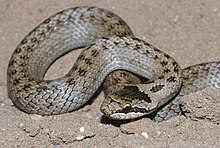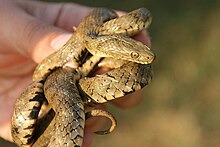List of snake species in Austria
This list contains all species and subspecies of the suborder of snakes (Serpentes) living in Austria . The basis for the list is Ulrich Gruber's Kosmos nature guide, The Snakes of Europe .
Species of snakes by families
| German name | Scientific name | family | Distribution in Austria | length | Toxicity | Subspecies in Austria | image |
|---|---|---|---|---|---|---|---|
| Smooth snake | Coronella austriaca | Colubridae | Open, sunny terrain with lots of hiding spots all over Austria | 50-70 cm | non-toxic and harmless | austriaca | |
| Aesculapian snake | Zamenis longissimus | Sunny areas on river banks and alluvial forests with thick bushes in the east of Lower Austria , in Burgenland , in southern and eastern Styria and in the south of Carinthia , Tyrol and Vorarlberg | 140-160 cm | non-toxic and harmless | no | ||
| grass snake | Natrix natrix | Natricidae | Moist meadows or forests, near bodies of water all over Austria | Males 60-70 cm, females 80-100 cm | non-toxic and extremely harmless | natrix, until 2017 helvetica | |
| Dice snake | Natrix tessellata | Bank areas of flat, warm, slowly flowing waters with rich bank vegetation in eastern Lower Austria, Burgenland, southern Styria and southern Carinthia | 60-90 cm | non-toxic and harmless | no | ||
| Adder | Vipera berus | Viperidae | Above all moors , swamps , quarries and mountain meadows in the area of the tree line throughout Austria | 60-75 cm | toxic ( tubular poison teeth ), cytotoxic effect, very painful bite, antiserum ! | berus | |
| Sand otter | Vipera ammodytes | Dry areas such as scree slopes with shrubbery, macchia or light oak forests, but also river banks and the edges of ponds and lakes in Carinthia and southern Styria | 60-80 cm | poisonous ( tubular poison teeth ), extremely strong and dangerous poison for humans with predominantly cytotoxic effects, antiserum ! | ammodytes | ||
| Meadow otter | Vipera ursinii | Grass steppe terrain with damp depressions or watercourses (like to build in rodents' earth burrows ); The last record of Europe's smallest venomous snake comes from Austria in 1973. | 35-50 cm | poisonous ( tubular poison teeth ), poison bite only weakly effective in humans, nevertheless swelling , paralysis and great pain are possible | rakosiensis |
See also
literature
- Ulrich Gruber: The snakes of Europe . Franckh-Kosmos Verlag, 2009, ISBN 9783440057537
- Heinz Grillitsch: Chronology of the extinction of the meadow viper, Vipera (Pelias) ursinii rakosiensis MÉHELY, 1893 in Austria. HERPETOZOA 23 (1/2): 25 - 50. Vienna






